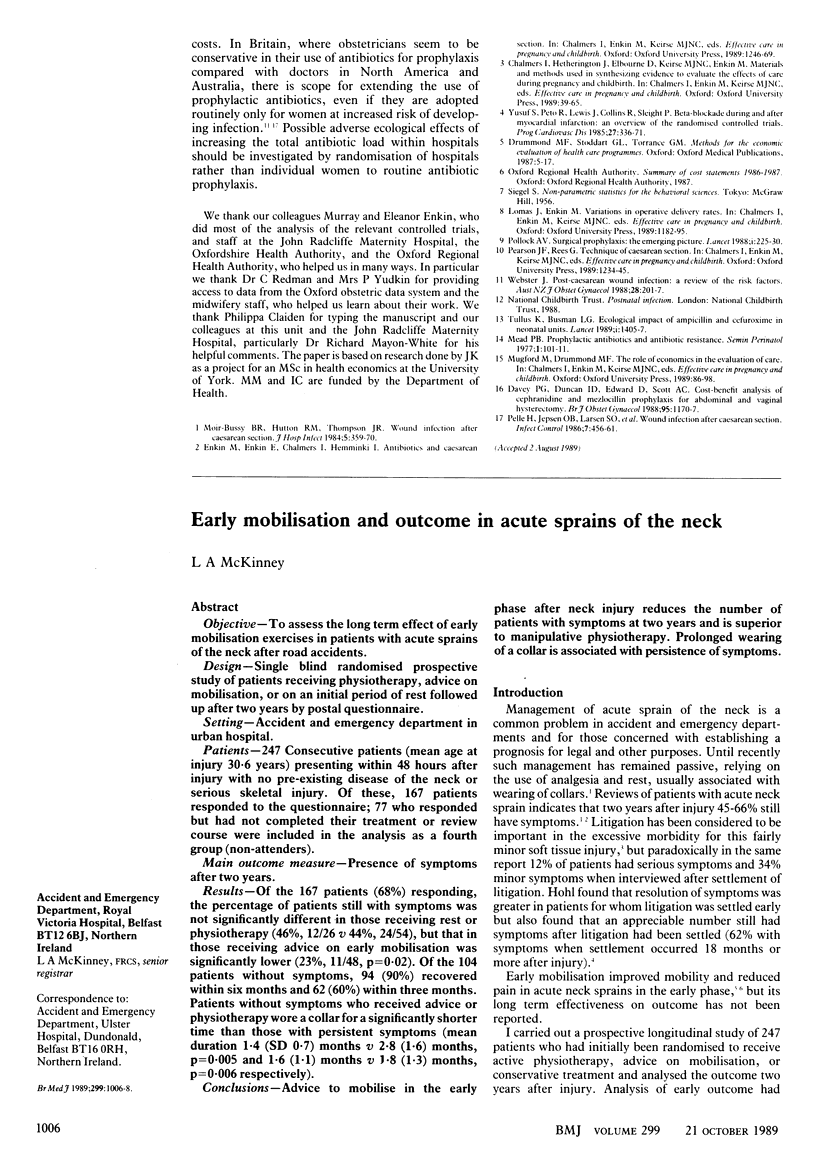Abstract
OBJECTIVE--To assess the long term effect of early mobilisation exercises in patients with acute sprains of the neck after road accidents. DESIGN--Single blind randomised prospective study of patients receiving physiotherapy, advice on mobilisation, or on an initial period of rest followed up after two years by postal questionnaire. SETTING--Accident and emergency department in urban hospital. PATIENTS--247 Consecutive patients (mean age at injury 30.6 years) presenting within 48 hours after injury with no pre-existing disease of the neck or serious skeletal injury. Of these, 167 patients responded to the questionnaire; 77 who responded but had not completed their treatment or review course were included in the analysis as a fourth group (non-attenders). MAIN OUTCOME MEASURE--Presence of symptoms after two years. RESULTS--Of the 167 patients (68%) responding, the percentage of patients still with symptoms was not significantly different in those receiving rest or physiotherapy (46%, 12/26 v 44%, 24/54), but that in those receiving advice on early mobilisation was significantly lower (23%, 11/48, p = 0.02). Of the 104 patients without symptoms, 94 (90%) recovered within six months and 62 (60%) within three months. Patients without symptoms who received advice or physiotherapy wore a collar for a significantly shorter time than those with persistent symptoms (mean duration 1.4 (SD 0.7) months v 2.8 (1.6) months, p = 0.005 and 1.6 (1.1) months v 1.8 (1.3) months, p = 0.006 respectively). CONCLUSIONS--Advice to mobilise in the early phase after neck injury reduces the number of patients with symptoms at two years and is superior to manipulative physiotherapy. Prolonged wearing of a collar is associated with persistence of symptoms.
Full text
PDF


Selected References
These references are in PubMed. This may not be the complete list of references from this article.
- Hohl M. Soft-tissue injuries of the neck in automobile accidents. Factors influencing prognosis. J Bone Joint Surg Am. 1974 Dec;56(8):1675–1682. [PubMed] [Google Scholar]
- McKinney L. A., Dornan J. O., Ryan M. The role of physiotherapy in the management of acute neck sprains following road-traffic accidents. Arch Emerg Med. 1989 Mar;6(1):27–33. doi: 10.1136/emj.6.1.27. [DOI] [PMC free article] [PubMed] [Google Scholar]
- Mealy K., Brennan H., Fenelon G. C. Early mobilization of acute whiplash injuries. Br Med J (Clin Res Ed) 1986 Mar 8;292(6521):656–657. doi: 10.1136/bmj.292.6521.656. [DOI] [PMC free article] [PubMed] [Google Scholar]
- Norris S. H., Watt I. The prognosis of neck injuries resulting from rear-end vehicle collisions. J Bone Joint Surg Br. 1983 Nov;65(5):608–611. doi: 10.1302/0301-620X.65B5.6643566. [DOI] [PubMed] [Google Scholar]


